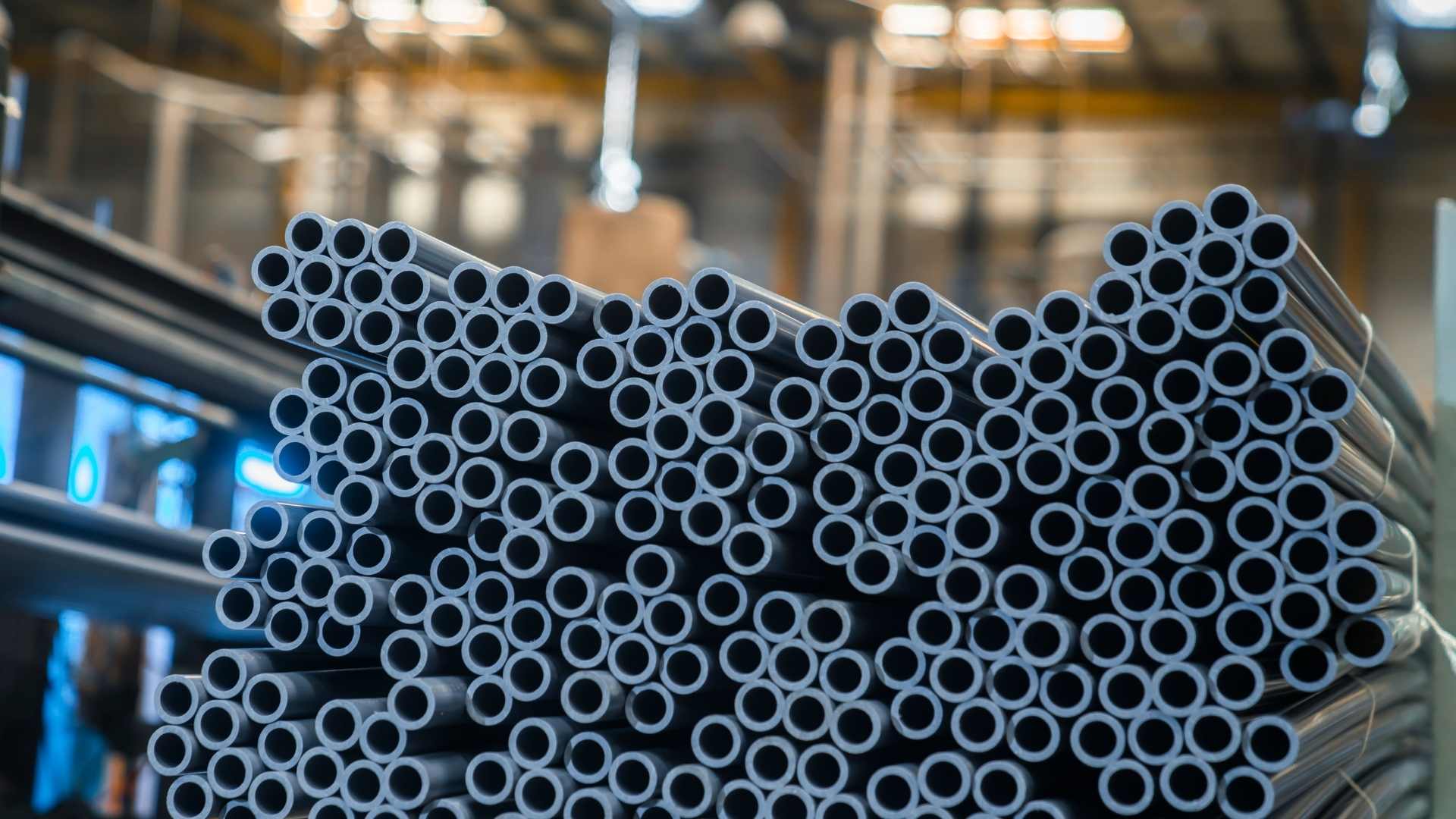How to install Tennis Courts in the Philippines?
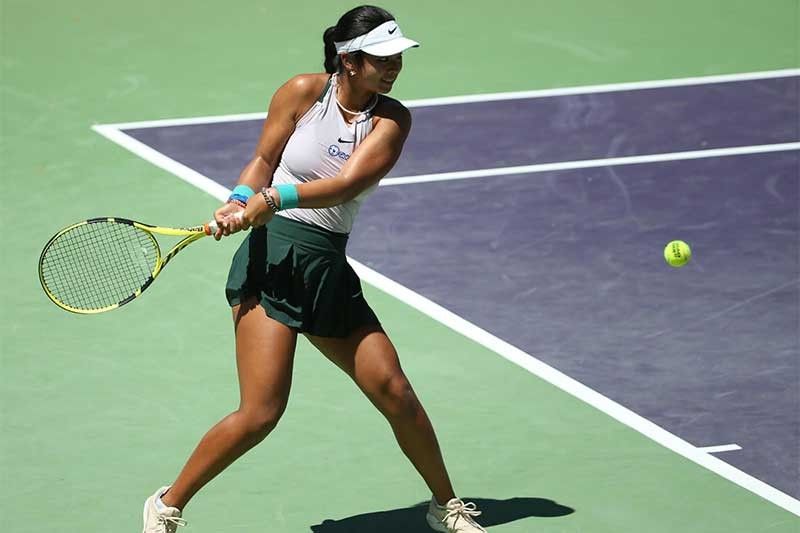
Source: Philippine Star
What is Lawn Tennis?
Tennis is a racket sport that can be played either solo (against one opponent) or in teams of two (each team has two players) (doubles). Each player hits a hollow rubber ball covered in felt over or around a net and into the other team's court using a tennis racket that is cord-strung. The game's goal is to move the ball in a way that prevents the other team from playing a legal return. The player who is unable to return the ball successfully will not receive a point; instead, the opponent will.
Tennis is an Olympic sport enjoyed by people of all social classes and ages. Anyone who can hold a racket can participate in the sport, including wheelchair users. In Birmingham, England, in the late 19th century, lawn tennis was the precursor to the modern game of tennis. It shared strong ties with both the older racket sport known as real tennis and other fields (lawn) games like croquet and bowls.
How to install a Lawn Tennis court?
You will find building a tennis court to be a simple task if you have experience with construction projects. However, in order to meet ITF standards, the surface must be finished well and the site conditions may necessitate complicated construction techniques. The types of materials you will use and the drainage systems that will be needed will depend more on the local climate and weather conditions. To allow for quick surface drainage, a tennis court should be constructed at a suitable slope (1.5 degrees minimum). Drainage channels or trench drains on the opposing side of the court or around the perimeter collect the runoff water.
Since our country experiences 20 typhoons on average each year, a porous concrete slab and permeable acrylic coating can be used. It enables rainwater to collect at the bottom and be removed by underground drainage pipes. When the water table is high, subsurface underground drain pipes (at least 75mm in diameter) installed beneath the coarse aggregate sub-base (gravel, stone, etc.) are also used.
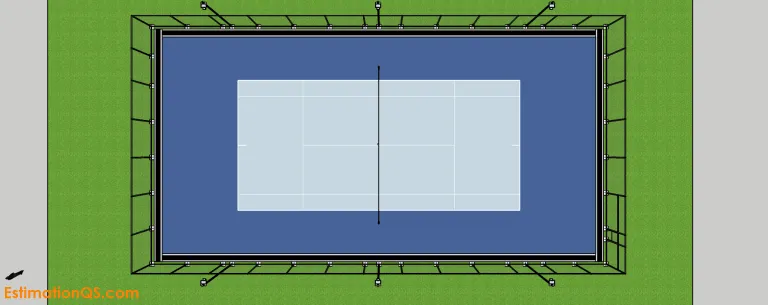
3D Plan – Acrylic Tennis Court, Aerial View of the finished project (Source: EstimationQS.com)
You must conduct initial site investigations before starting construction activity:
Underground Services
Look into whether there are any buried telecommunications, electrical, drainage, or water supply systems. Finding the pipes, cables, conduits, etc. will help you decide whether to move them to a different location away from underground services or to reposition them.
Overhead Services
A fence around a tennis court is necessary (backstop and side screen). The fence should be no taller than 3,660mm and no less than 3,100mm. Verify that there are no overhead service lines crossing the court, such as telecom and electricity lines.
Clear Site
When you have found the ideal location for your tennis court, you should clear the area of all vegetation by chopping down any bushes, trees, shrubs, or grass, removing any debris, and grubbing up any grassroots.
Tennis Court Dimensions
Doubles court – 23.77 x 10.97m
Singles court – 23.77 x 8.23m
Fence perimeter – 36.58 x 18.29m
Clear site – 3000mm to the perimeter. [42,500×21,290mm]
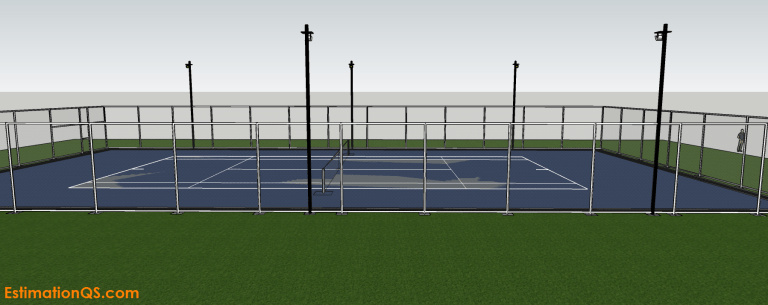
Acrylic Tennis Court, side elevation (Source: EstimationQS.com)
Excavate Topsoil
The ground should be level and sufficiently densely compacted. The goal is to create level formations that can serve as a starting point for deeper-level excavations.
Topsoil excavation – 150mm deep.
Excavate to subgrade level
The tennis court substructure has a total depth of 260mm from the ground. As a result, the subgrade level is 260 mm below the floor. The excavation depth is 110mm (260 - 150).
Dig trenches for underground pipes
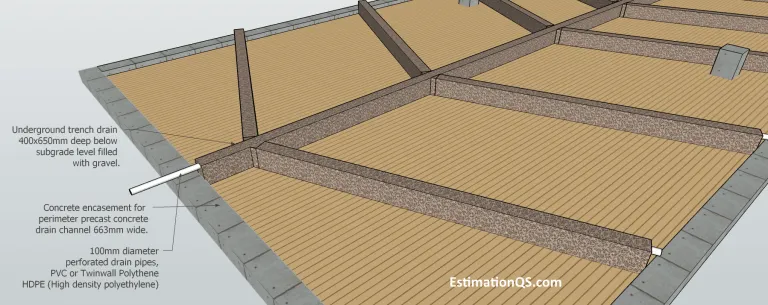
3D Design – Acrylic Tennis Court, underground trench drain pipe details. (Source: EstimationQS.com)
You must dig trenches for underground drain pipes starting at the subgrade level if the engineer has specified them. Under the court, the project's drain pipes will be laid in a herringbone pattern.
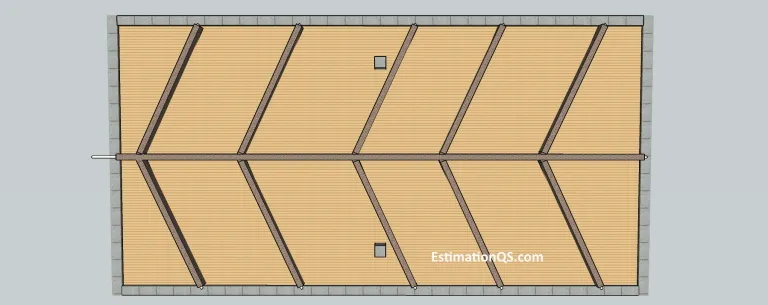
3D Plan – Acrylic Tennis Court, underground herringbone pattern drainage system.
Lay Down Geofabric Membrane
Over the compacted subgrade formations, a Geofabric membrane or textile is placed. The trench drain will also be covered by it. The geosynthetic membrane is covered with a 32mm layer of sand. After that, a suitable slope is created for the placement of perforated drain pipes over the sand bed, and the pipes are covered with 8mm stone aggregate (sub-base filling).
Other steps under the preliminary investigation are:
- Subbase Filling
- Reinforced concrete slab
- Acrylic Surface coating
- Paint lines
The second part of the installation process is:
Dig Holes for Net Posts
The concrete foundation bases for the net posts will be 760x760x1300mm deep (1300mm deep from floor level). The post will be twice as long overall, including the depth above floor level. The height requirement set by the International Tennis Federation (ITF) is 1.07m, neither less nor more. As a result, the total length will be 1.07 x 2 = 2.14 m.
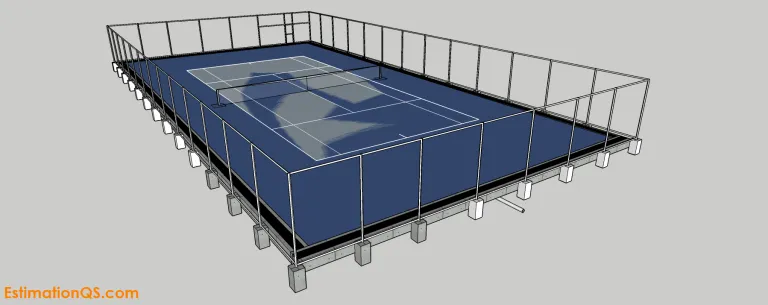
3D Rendering – Acrylic Tennis Court, Steel fence posts, rails, and concrete foundation bases.
Net Post Details
Steel posts shall be used for this project. According to ITF requirements, the diameter or square width of a net post shall not exceed 150mm (6 inches).
Dig Trenches for PC Drain Channels
Around the court's perimeter, precast concrete drain channels will be installed. The BGU-Z SVV System, which has dimensions of exterior width of 363mm, internal width of 300mm, and 340mm high, is a good fit for the recommended PC drain channels for this project.
Fence Post Details
The range for ITF post height is 3,100 to 3,660mm.
- Corner/End Posts: 5.8 mm thick, 5.02 kg/m, 60 mm internal diameter, and 70 mm external diameter. offered in lengths of three or six meters.
- Top/Bottom Rails: 5.55kg/m, 5mm thick, 40mm internal, 50mm external.
Gates: One of these two options will apply to the steel tube section diameter for the gate:
- 27mm outer, 20mm internal diameters, 3.5mm thick, 2.028kg/m.
- 32mm outer, 25mm internal diameters, 3,5mm thick, 2.46kg/m.
Dig Holes for Light Poles
Posts for fences will have deeper foundations than those for outdoor light poles. A 6700mm high light pole will need a 400x400x1000mm deep concrete foundation base for this project. The pole's total length is calculated by adding the [floor-to-sky height] to the [foundation height - 76mm]. Accordingly, the overall length is 6700mm + (1000-76mm) = 7624mm.
Tennis Light Post
Round steel light posts, 10mm thick, 22.2kg/m, 80mm internal, 100mm external diameters.
Height – 6700mm (minimum)
Spacing – 12,769mm centers.
Required Posts – 6 No.
Foundation – 400x400x1000mm deep.
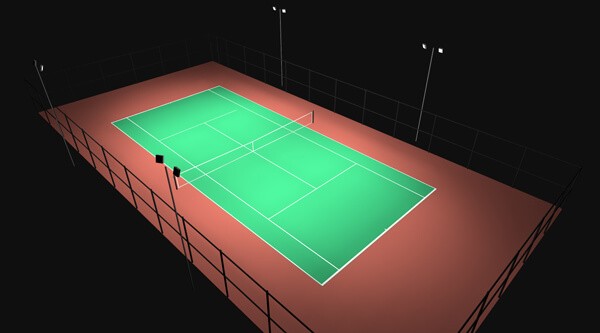
Source:MFG.com
Install Chain link fence
A tennis ball cannot pass through a chain link fence if the openings in the wire mesh are larger than the tennis ball's diameter. It is suitable to use diamond mesh with openings that are no larger than 38mm x 38mm.
Install the Tennis Net
The International Tennis Federation (ITF) established the standard tennis net specifications, which are 1.07 meters high at the posts and 0.914 meters high in the center, and 12.8 meters in width between the posts. The steel eyebolt with a 19mm screw anchor is embedded in a concrete cube base, of sides 305mm, beneath the court surface.
Types of Eyebolt
- Forged
- Plain or Regular
- Collared
- Machinery
- Swivel
To know more about different types of eyebolts available in the Philippines, click here.
Types of tennis nets
Tennis nets can be divided into full-size, portable, and rebound, which are the three primary categories.
Full-size Singles and Double Nets
You should buy a full-size net if you have a regular tennis court. However, you'll need to choose between a doubles or singles net based on the layout of your court. The size difference is as follows:
source: tenniscompanion.org
Portable Nets
If you’re in the market, here are a few qualities we look for in a portable tennis net that are worth considering:
- Freestanding
- Lightweight
- Durable
- Stable
- Easy to pack
- Height adjustable
- Included bag for travel
Rebound Nets
A rebound net is a sizable, free-standing net with a strong, robust frame that doesn't divide the court. Here are a few qualities we look for in rebound nets:
- Large net
- Durable
- Consistent bounce back
- Portable
- Adjustable angle
Eminent Net Brands
1.Edward Sports
The building methods that Edwards Sports uses vary depending on the net and the intended application. The few areas of concentration that they may change from one net to the next are listed below.
- Headband material, i.e., polyester vs. vinyl
- Headband stitching, i.e., double vs. quad
- Netting thickness, i.e., 2.5 vs. 3.5 mm
- Single vs. double netting
- Length, i.e., singles vs. doubles
2. Douglas
Like Edwards Sports, Douglas produces equipment for a wide range of activities, including tennis, basketball, baseball, hockey, pickleball, and volleyball, to name a few. As far as tennis nets go, here are the options Douglas offers:
- Professional Nets
- TN-45
- TN-40
- Championship Nets
- TN-36 – Tapered
- TN-36DMT – Tapered
- TN-28DM
- Tournament Nets
- TN-30
- TN-30DM – Tapered
3.HarTru
Henry Robinson created their distinctive clay surface in 1931 and has prospered by outfitting courts all over the world.Today, they sell the following line of tennis nets:
- Har-Tru Courtmaster Pro Tour
- Har-Tru Courtmaster DHS
- HAr-Tru Courtmaster Deluxe
- Har-Tru Regency
- Har-Tru Royale
- Har-Tru Revolution
4.Gamma
Gamma, which is well-known in the business for its tennis strings and stringing machines, also provides a variety of court accessories, including tennis balls, nets, ball hoppers, and scorekeepers. Their current selection of tennis nets includes the following:
- Gamma Pro Net
- Gamma Tuff Net
- Gamma Super Tuff Net
- Gamma Premium Net
5.Tourna
Tourna introduced a distinctive light blue overgrip in 1972, and it has since become a standard in the sport. Tourna offers a handful of options to consider:
- Tourna 3.0 mm Single Net
- Tourna 3.0 mm Double Net
- Tourna Deluxe 3.5 mm Single Net
- Tourna Deluxe 3.5 mm Double Net
- Tourna Deluxe 3.5 mm Double Net with Polyester Headband
6.Vermont
Here’s a list of the tennis nets they currently offer:
- Vermont 2.0 mm Doubles Net
- Vermont 2.5 mm Singles Net
- Vermont 2.5 mm Doubles Net
- Vermont 3.0 mm Doubles Net
- Vermont 3.5 mm Championship Singles Net
- Vermont 3.5 mm Championship Doubles Net
7.MacGregor
If you’re on the hunt for an affordable no-frills tennis net then, MacGregor might be right up your alley. They offer two tennis nets:
- MacGregor Varsity 300
- MacGregor Super Pro 5000
To know more about net specifications, click here.
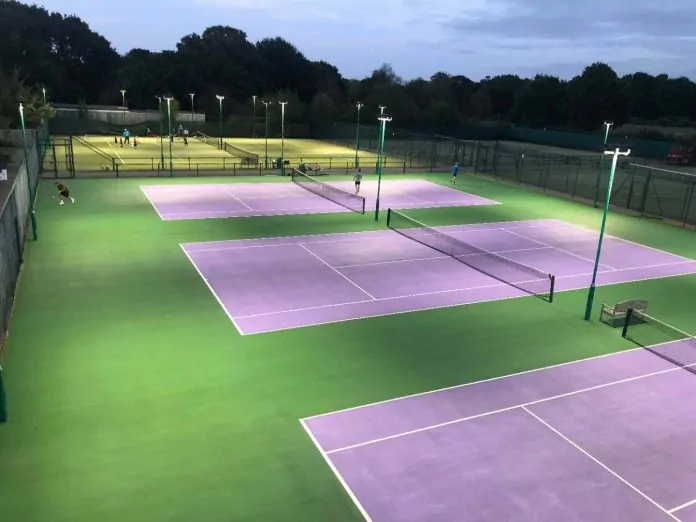
source:oppstrend.com
After net installation, we can now proceed to the last step which is installing the Court lights. This is very necessary especially when you play at night. Prior to creating your tennis court, it's crucial to consider the necessary lighting levels. The lux levels, for instance, require special attention. The minimum lux level for these facilities, according to the experts, should be about 100 lux. With this, the venue will have the ideal lighting for those late-night games. Keep in mind that these facilities need enough lighting. Consult an expert as a result. Get assistance from a light professional.
Additional Information
Looking for Tennis Courts in the Philippines? Find it here.




